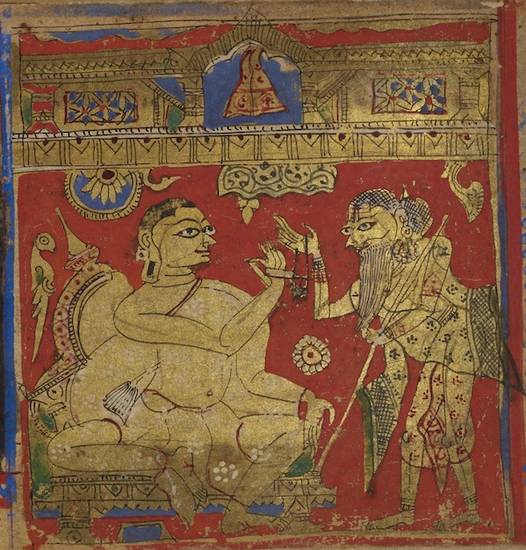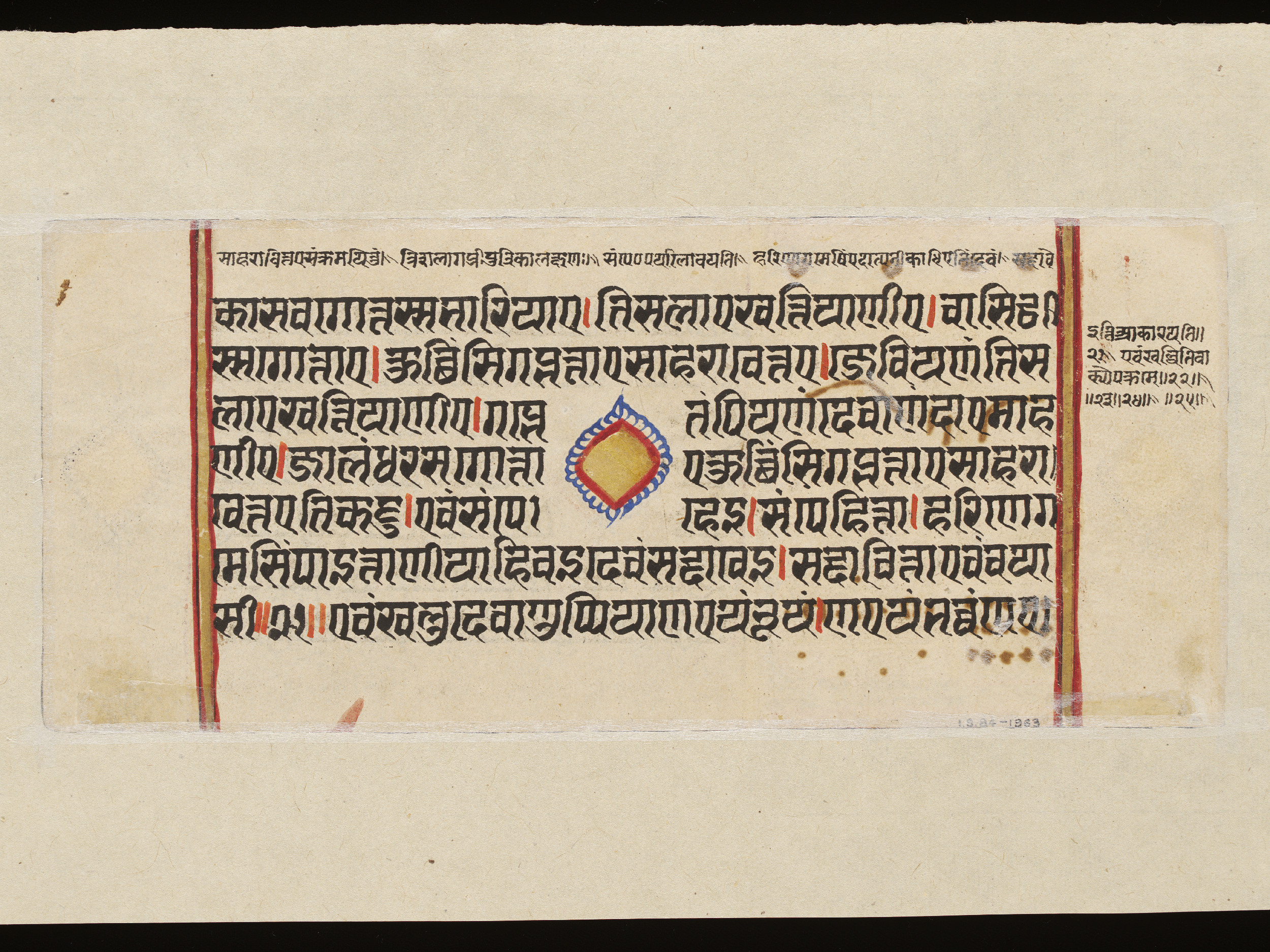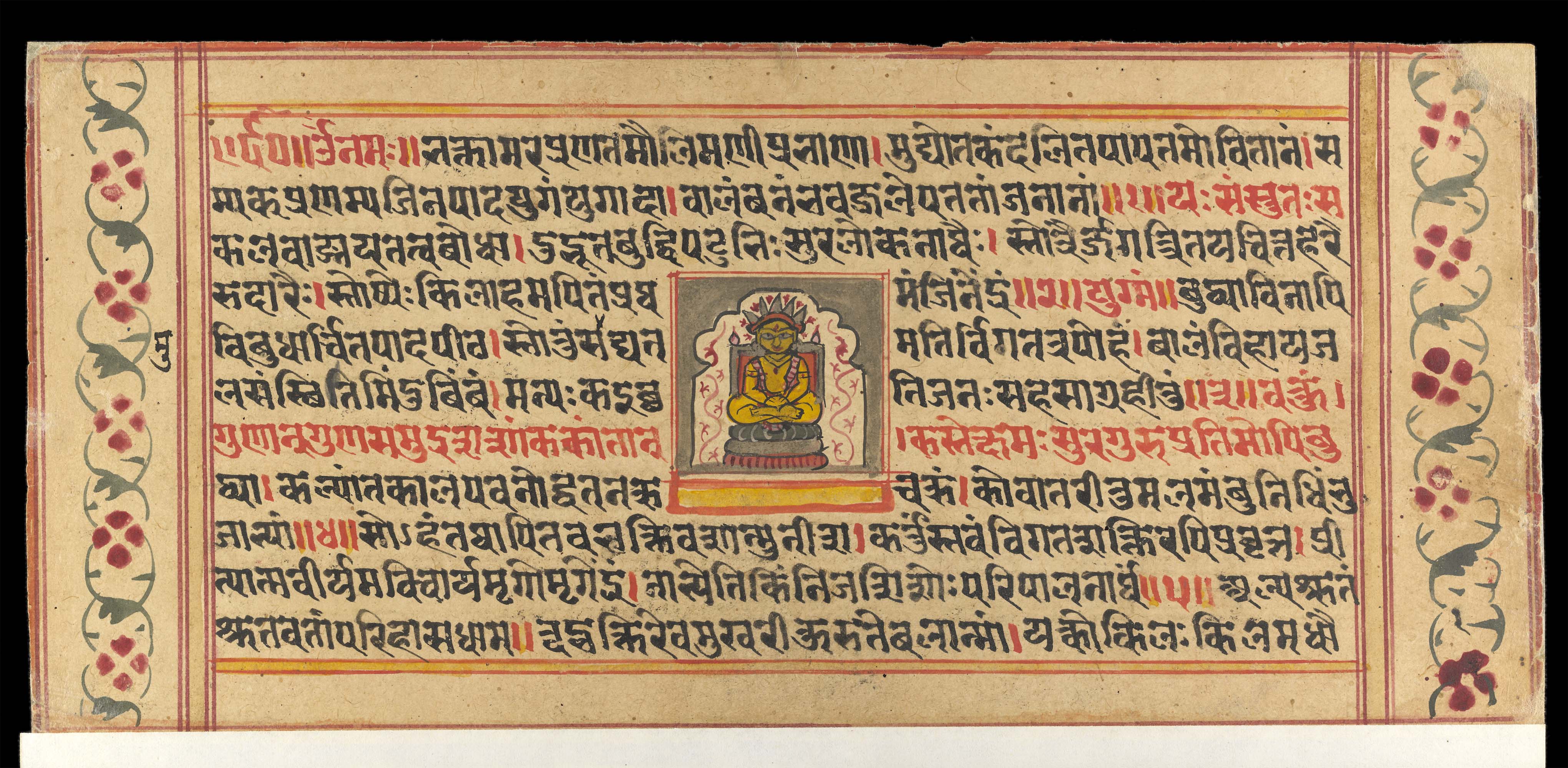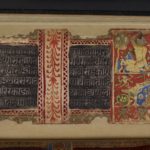Article: Hermann Jacobi
One of the most important European Indologists, Hermann Jacobi (1850–1937) was a pioneering scholar and a very major figure in Jain studies. He is known for two main intellectual achievements. Firstly, in 1879 he demonstrated definitively that Jainism had been separate from Buddhism from the earliest times. Before that, it was commonly stated that Jainism was an offshoot of Buddhism. Secondly, Jacobi produced numerous editions of Jain texts in Sanskrit, Prakrit and Apabhraṃśa, as well as translations. Many of these have remained the standard reference works for students and scholars.
Just as crucial for the development of Jain studies is the Jacobi collection of Jain manuscripts. In 1897 Jacobi sold his collection of manuscripts to the British Museum. Now housed in the British Library, this collection is one of the main sources for Jain manuscripts in the United Kingdom. Many of Jacobi’s manuscripts are digitised on JAINpedia.
Life and academic career
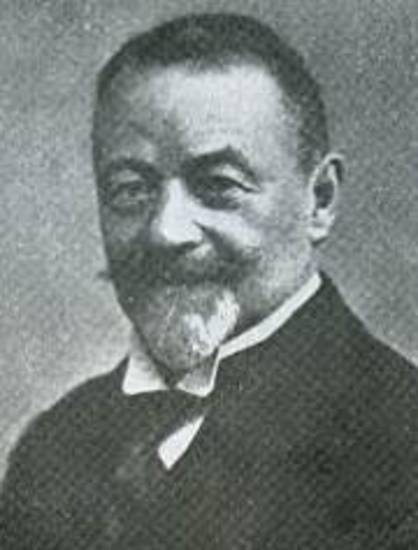
Hermann Jacobi
Image by unknown © unknown
Hermann Georg Jacobi was born in Cologne in Germany on 11 February 1850. Scholars from the German-speaking nations have long formed a prominent branch of European Indologists. At the University of Berlin, Jacobi was a pupil of Albrecht Weber, a giant of Indology and an early scholar of Jain studies, with whom he studied Sanskrit and comparative linguistics. He also studied mathematics at an advanced level. He obtained his doctorate from Bonn University in 1872 with a thesis on astrological terminology.
Jacobi had a very long academic career, and taught Sanskrit at the universities of Münster, from 1876, Kiel from 1885 and Bonn. He retired in 1922 but continued to publish until the end of his life. A festschrift was published in his honour in 1926, offered to him by his pupils, colleagues and friends. Bonn is where he stayed the longest and where he died in 1937. Jacobi’s archive was kept in Bonn University after his death, but it was destroyed during the Second World War.
Jacobi travelled in India on two occasions. He first travelled around western India and northern India in 1873 to 1874, searching for manuscripts. His second trip took place over 1913 to 1914. Initially Jacobi went to Kolkata, where he was invited to give lectures and was awarded an honorary doctoral degree. He also went to Ahmedabad, in Gujarat, searching for Jain texts in Apabhraṃśa. He was awarded the title Jaina Darśana Divākara – Sun of Jain Doctrine – at the All-India Jain Literary Conference, held in Jodhpur in Rajasthan under the auspices of Ācārya Vijayadharma-sūri.
Like most Indologists of the time, Jacobi had a very broad scope of research. The fields to which he contributed very significantly are:
- astronomical literature
- problems of chronology in ancient India
- linguistic studies relating to Vedic Sanskrit, classical Sanskrit, Prakrit and Apabhraṃśa
- Indian prosody and metrics
- rhetoric and poetical treatises – alaṃkāra-śāstra
- Sanskrit epics, especially studies of the Rāmāyaṇa
- studies in Indian philosophical thought and logic.
Contribution to Jain studies
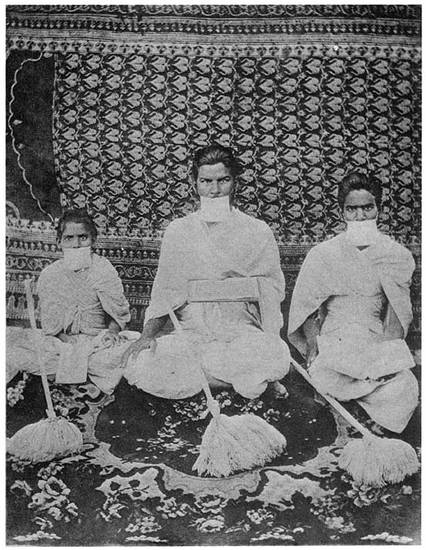
Three Śvetāmbara Sthānaka-vāsin monks
Image by R. V. Russell and Rai Bahadur Hira Lāl © public domain
The intellectual arena in which Jacobi’s contribution marks a turning point and opened many new scholarly avenues is that of Jain studies. His proof that Jainism is an independent religion paved the way to its study as a separate discipline. Jacobi’s efforts to increase the number of Indian texts available to Indological scholars were also crucial in advancing scholarly research into Indian religion, philosophy, languages and culture. His editions and translations of these texts were frequently the first in the West and are often still used as the standard works in Western scholarship. Jacobi’s literary and linguistic research shows a depth of insight and intellectual ability that ensures his work is highly relevant even today.
Probably Jacobi’s most significant achievement is his demonstration that followers of the Jinas have always had beliefs and practices distinct from those of other Indian religions. This challenged the idea widespread among Western observers and scholars that the Jains formed a branch of the Buddhist or Hindu faiths.
Jacobi continued the task that had been started by his teacher Albrecht Weber in expanding the number and study of Jain texts available to scholars. Weber had managed to get a good collection of Jain manuscripts from India into the Berlin Royal Library and had himself published several important studies. Jacobi used the Berlin Jain manuscripts in his research and added some he had collected himself, considerably enriching the number of Jain texts accessible to intellectuals. Before him, such works were extremely limited, not just in the West but also in India.
Proving Jainism is a distinct religion
Jacobi’s introduction to the edition of the Kalpa-sūtra in 1879 and his 1880 article entitled ‘On Mahāvīra and his predecessors’ are landmarks in the history of Jain studies. The introduction states the problem in clear terms:
Before entering upon an inquiry about the date of Mahāvīra’s Nirvāṇa, we must first discuss the question whether Jainism and Buddhism had each its separate and independent origin or the one was a division of the other
1879, page 1.
For the first time Jacobi provided textual evidence that the Jain tradition was distinct from both Hindu and Buddhist traditions. In the introduction Jacobi pointed out how Jains are referred to in Hindu and Buddhist scriptures not as ‘Jaina’ but under the name niggantha – without knot – that is, free from possessions and attachment. Secondly, he proved that Jains have always claimed the founder of their religion in this era to be Ṛṣabhanātha or Lord Ṛṣabha. As a near contemporary of Buddha, Mahāvīra had been thought of as the founder of Jainism by outsiders.
Before Jacobi’s findings, Jains were considered to be a Buddhist or Hindu offshoot and not an independent tradition. In his introduction Jacobi reviewed the opinions of Western scholars such as H. H. Wilson and E. T. Colebrooke, who had promoted this idea. This belief had taken hold because in the 18th and 19th centuries the Jains in India did not present any textual evidence in public about themselves and the historical situation forced them to remain either very discreet or almost hidden.
Jacobi’s evidence was based on his deep knowledge of the scriptures of the Indian religions of Hinduism and Buddhism. These texts call Jains ‘niggantha’. They are described as one of the numerous ‘heretic‘ groups that were active in north-eastern India during the 6th to 5th centuries BCE. The Jains themselves also used ‘niggantha’ in some of their early scriptures to mean Jain ascetics. The proper name Nigantha Nātaputta found in the Buddhist texts refers to the leader of the ‘nigganthas’ and can be identified with Mahāvīra. Jacobi concluded that ‘Buddha and Mahāvīra were two distinct persons but contemporaries’ (1879: 6). The opinions the Buddhists credit to Nigantha Nātaputta are in general accordance with Jainism.
Jacobi’s studies of Jain writings also demonstrated that Mahāvīra, the 24th Jina, was not the founder of Jainism but a reformer. His teaching was a reform of the principles put forward by his predecessor, Pārśvanātha or Lord Pārśva, the 23rd Jina. But this does not mean that Pārśva founded Jainism. The Jain tradition is unanimous in making Ṛṣabha the first Jina and the true founder of Jain beliefs in this era.
Editions and translations of Jain texts
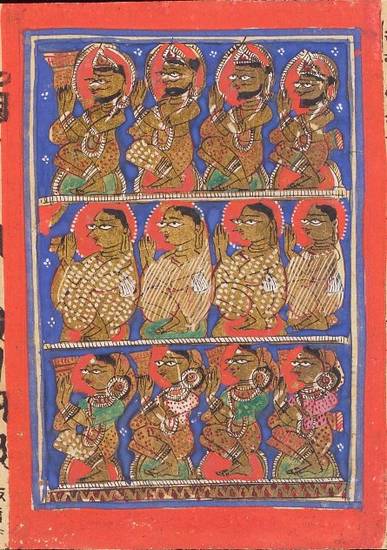
Fourfold community
Image by Wellcome Trust Library © Wellcome Library, London
In Jacobi’s time editions of Jain texts were in their infancy. Indian editions of Jain canonical texts had hardly started. Rather than editions, they were really kinds of reproductions of manuscripts, which had not been selected on scholarly principles. Jacobi’s editions are thus either the first or the first deserving this name. They are critical editions based, whenever possible, on a choice of manuscripts, either in his own collection or borrowed from India.
Some of the editions were followed or accompanied by translations by Jacobi himself, while some texts were translated later by other scholars.
Jacobi’s insight is seen from the fact that the works he concentrated on are all classics of Jainism. These are deeply important for understanding the history of the faith, its doctrine, its practice and its literary history. His research focused on the Śvetāmbara canonical scriptures, especially the Kalpa-sūtra, and the basic text of Jain teaching, the Tattvārtha-sūtra. He studied Sanskrit hymns and Śvetāmbara narrative literature in Prakrit and Sanskrit. He also carried out research into the totally new field of narrative literature in Apabhraṃśa.
Texts that Jacobi researched
Throughout his lengthy academic career and his retirement, Jacobi carried out groundbreaking research on a great number of key Jain texts.
Śvetāmbara canonical scriptures
Jacobi studied works belonging to the Śvetāmbara canon. Of these, he edited and translated the Ācārānga-sūtra and the Kalpa-sūtra. From his interest in the Kalpa-sūtra come several editions of related texts, such as those dealing with the lives of early Jain teachers, in particular Kālaka and other figures in Hemacandra’s Sanskrit epics.
Jacobi translated the Sūtrakṛtānga, and the Uttarādhyayana-sūtra along with stories from Devendra’s commentary. These last were edited in his book Ausgewählte Erzählungen in Māhārāṣṭrī (Selected Stories in Māhārāṣṭrī).
Tattvārtha-sūtra and hymns
Jacobi devoted time to the fundamental treatise of Jain teaching, the Tattvārtha-sūtra. His edition provided the Sanskrit text, a German translation, an introduction and word-index.
He also studied popular Sanskrit hymns commonly used in Jain liturgy, namely the:
- Bhaktāmara-stotra
- Kalyāṇamandira-stotra
- Śobhana-stuti.
Śvetāmbara narratives
Jacobi carried out extensive research into Śvetāmbara narrative literature, covering writings in both Prakrit and Sanskrit.
He worked on key Prakrit Śvetāmbara texts, editing and translating two versions of the Kālakācārya-kathā or the story of the teacher Kālaka. He edited and gave a detailed introduction to Haribhadra‘s Samarāiccakahā – a lengthy tale that shows how karma and rebirth work in the lives of various characters. He also edited Vimala-sūri’s Pauma-cariya. This is the first Jain retelling of the Rāmāyaṇa, with a very interesting prologue where the author criticises various episodes of the Hindu Rāmāyaṇa story, pointing out their inconsistencies or lack of logic.
Jacobi edited the following Sanskrit stories:
- Siddharṣi’s Upamitibhavapra-pañcakathā – a long ninth-century allegorical narrative showing the functioning of karma and rebirth.
- Hemacandra’s Pariṣiṣṭa-parvan – a 12th-century epic poem very important for the legendary history of the early Jain church, noting the teachers who came after Mahāvīra.
- Pradyumna-sūri’s Samarāditya-saṃkṣepa – a 13th-century Sanskrit retelling of Haribhadra’s Samarāiccakahā.
Apabhraṃśa narratives
Jacobi conducted research into narrative literature in Apabhraṃśa, a completely new intellectual field at the time. His aim was to show how this late Prakrit dialect was used as a literary language.
Jacobi had access to one or two manuscripts through Jain friends he was in contact with during his second stay in India, in 1913 to 1914. They got photographs of the manuscripts for him to study. But Jacobi also copied parts of the text on the spot, working from morning to evening, as he himself narrates (1918:1*). In this way he worked on two texts – the Bhavisatta-kaha and the Sanatkumāra-cariu.
He edited Dhaṇavāla’s Bhavisatta-kaha, a version of the story of Bhaviṣyadatta written in the 10th century by a Digambara author. Bhaviṣyadatta is a literary figure connected with the Jain festival of Jñāna-pañcamī or Śruta-pañcamī. During the festival devotees worship the scriptures and keep specific fasts.
Jacobi produced a critical edition and translation of Sanatkumāra-cariu. This is a legend found in the larger work called Neminātha-cariu by Haribhadra, who belonged to the monastic lineage of Śrīcandra-sūri and was active during the 12th century. This is the story of Sanatkumāra, the fourth of the 12 universal monarchs. A very handsome man, he was proud of his looks until the god Śakra decided to test him by making him ugly. He then realised the impermanence of anything worldly, a key teaching of Jainism. Sanatkumāra suffered many diseases and became an ascetic.
Linguistic and literary studies
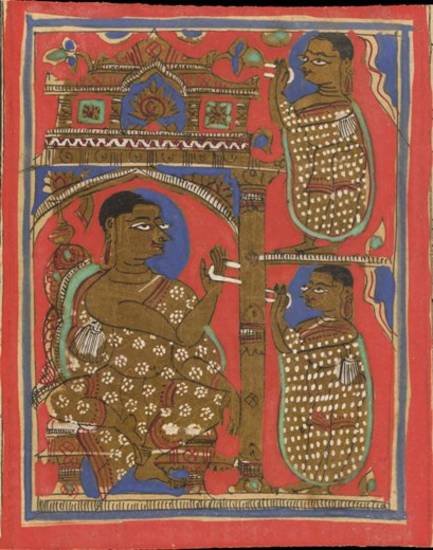
Teaching scene
Image by British Library © CC0 1.0 (Creative Commons Public Domain)
Several editions Jacobi produced have introductions on grammar and glossaries. All these tools were needed for texts written in the various Prakrits because hardly any manual was available then. Thus his works are both scholarly and pedagogical. This was the way trained philologists of that period approached languages that were almost newly discovered, providing all the necessary tools to potentially interested learners.
Jacobi’s Ausgewählte Erzählungen in Māhārāṣṭrī (Selected Stories in Māhārāṣṭrī), published in 1866, starts with a comprehensive description of Jaina Māhārāṣṭrī Prakrit and has remained a classic for generations of students of Prakrit in the West. It provides a critical edition of the most important stories taken from Devendra’s commentary on the Uttarādhyayana-sūtra, such as those of the four Pratyekabuddas or that of Agaḍadatta. The lucid and simple complete glossary makes it a very valuable reader.
At the time Jacobi edited the Bhavisatta-kahā and the Sanatkumāra-cariu, the late form of Prakrit called Apabhraṃśa had never been described properly. It was known mainly from quotations of stray verses found in the works of the Indian grammarians. The linguistic introductions and the glossaries he produced are thus important academic tools.
Jacobi’s general interest and proficiency in Indian prosody combined with his thorough knowledge of Śvetāmbara canonical books led him to identify the form known as veḍha in 1885. This technical term is called veṣṭaka in traditional Sanskrit. Veḍha is the long word-compounds that form metrical units, although they look like ordinary prose and are found within prose texts. They are inseparable from the stock descriptions – varṇaka – of persons, animals, objects or places that are a typical stylistic component of Jain canonical prose. Jacobi’s seminal contribution later helped other scholars to recognise similar elements in early Buddhist literature.
Jacobi’s collection at the British Library
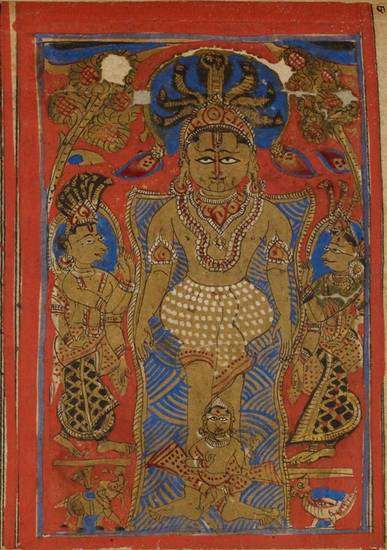
Pārśva, yakṣiṇī and Dharaṇendra
Image by British Library © CC0 1.0 (Creative Commons Public Domain)
The biggest collection of Jain manuscripts in the United Kingdom is at the British Library, a large number of which had originally been owned by Jacobi. As had many European Indologists of the time, Jacobi had looked for and bought original manuscripts in the subcontinent to study. The British Library owns the collections Jacobi had first bought or given to the British Museum and the India Office, the government department responsible for the British colony of India.
As a very valuable part of the British Library Jain holdings, the Jacobi collection is therefore fully described in the Catalogue of the Jaina Manuscripts at the British Library (Balbir, Sheth, Tripathi: London, 2006). The wide-ranging topics of the manuscripts include Jain religious writings, ethics, grammar, philosophy, astronomy and hymns. Many of the holdings form an almost complete body of classical and contemporary Śvetāmbara Jain doctrine and practice, with a particularly fine example of the Kalpa-sūtra.
As the basis of Jacobi’s scholarly work for some twenty years, the collection is also of great interest to later students of Jainism.
Acquisition in India
The second part of the 19th century was an active period for the discovery of new evidence about the religious traditions of India. This evidence came from manuscripts found in searches arranged by institutions set up in British India. Several European scholars took part in this task. Western India – namely Gujarat and Rajasthan – was one of the main regions where systematic manuscript-seeking tours were organised, with the help of local Indian agents. The local agents knew the small towns and libraries that held promising material. During these tours a lot of Jain material came to light.
The Austrian Indologist Georg Bühler went on successive tours. In the winter of 1873 and 1874, Hermann Jacobi joined him and aided his mission of collecting and copying. They visited Jodhpur, Jaisalmer and Bikaner, all in Rajasthan. Bühler writes:
[Jacobi] acquired also at Bikaner, while on a tour with me a good collection of Jaina books […]. He very courteously asked for my permission, which I readily gave, as I was unable to take more than a small fraction of the heaps of MSS. which the Bikaner Dalâls brought every day to our tents.
When the local people knew that scholars were coming, they were keen to sell manuscripts. Many duplicates emerged. Those that were not selected were either destroyed or recycled by paper-merchants.
Reading
- Kleine Schriften
Walther Schubring - edited by Klaus Bruhn
Glasenapp Stiftung series; volume 13
Franz Steiner Verlag GmbH; Wiesbaden, Hesse, Germany; 1977
- ‘Zwei Jaina-stotra’
Hermann Jacobi - Indische Studien
volume 14
Deutsche Morgenländische Gesellschaft; Berlin and Leipzig, Germany; 1876
- 'The Kalpa Sûtra of Bhadrabâhu'
Bhadrabāhu - translated and edited by Hermann Jacobi
Abhandlungen für die Kunde des Morgenlandes
Deutschen Morgenländischen Gesellschaft series; series editor Otto Loth; volume VII: 1
F. A. Brockhaus; Leipzig, Saxony, Germany; 1879
- Sthavirāvalicarita or Pariśiṣṭaparvan: Being an appendix of the Triṣaṣṭiśalākāpuruṣacarita
Hemacandra - edited by Hermann Jacobi
volume 96
Royal Asiatic Society of Bengal; Calcutta, India; 1883
- Ausgewählte Erzählungen in Māhārāṣṭrī: zur Einführung in das Studium Prâkrit
Hermann Jacobi - S. Hirzel; Leipzig, Saxony, Germany; 1886
- Samarādityasaṃkṣepa
Pradyumnasūri - edited by Hermann Jacobi
Ahmedabad, Gujarat, India; 1906
- Paūmicariyam
Ācārya Vimala-sūri - translated by Hermann Jacobi
Prakrit Text Society; Varanasi, India; 1962
- Samarāiccakahā
Haribhadra - edited by Hermann Jacobi
Bibliotheca Indica series; volume 169
Asiatic Society of Bengal; Calcutta, India; 1926
- Sanatkumāracaritam, ein Abschnitt aus Haribhadras Neminathacaritam: Eine Jaina-Legende in Apabhraṃśa
Haribhadra - edited by Hermann Jacobi
Abhandlungen der Königlich Bayrischen Akademie der Wissenschaften. Philosophisch-philologische und historische Klasse series; volume XXXI: 2
Verlag der Bayrischen Akademie der Wissenschaften; Munich, Germany; 1921
- ‘Indische Hypermetra und hypermetrische Texte’
Hermann Jacobi - Indische Studien
edited by Albrecht Weber
Deutsche Morgenländische Gesellschaft series; volume 17
F. Dümmler (Berlin), F. A. Brockhaus (Leipzig); Berlin and Leipzig, Germany; 1885
- Studies in Jainism: Being a collection of three original, important, and informative articles on Jainism
Hermann Jacobi - edited by Muni Jina Vijaya
Jaina Sahitya Samsodhaka Karyalay; Ahmedabad, Gujarat, India; 1946
- ‘Hermann Jacobi (1850–1937)’
Louis Renou - Journal Asiatique
volume 230
École Française d’Extrême-Orient; Paris; 1938
- Catalogue of the Jain manuscripts at the British Library: including the British Museum and the Victoria and Albert Museum
Nalini Balbir, Kanhaiyalal Sheth, Kalpana Sheth and C. B. Tripathi - British Library & the Institute of Jainology; London, UK; 2006
- ‘The Invention of Jainism: A Short History of Jaina Studies’
Peter Flügel - Journal of Jain Studies
volume 11
Kyoto, Japan; 2005
Links
- Kalpa-sūtra of Bhadrabāhu – Gallica Bibliothèque numérique
-
This manuscript of the Kalpa-sūtra is fully digitised on the Gallica Bibliothèque numérique website, part of the Bibliothèque Nationale de France (National Library of France) in Paris. Though the website is available in English, the information about the artefact is in French.
- Mahāvīra renounces
-
This illustration is from a page of the Śvetāmbara scripture of the Kalpa-sūtra in the collections of the Philadelphia Museum of Art. It shows the last Jina, Mahāvīra, performing the rite of keśa-loca – ‘pulling out of the hair’ – which indicates indifference to the body. It is part of the initiation ceremony of dīkṣā, in which an initiate renounces the world and becomes a mendicant. He is watched by Śakra, king of the gods, who takes an active role in the lives of the 24 Jinas.
http://www.philamuseum.org/collections/permanent/105108.html?mulR=656|9
- British Library – India Office records and private papers
-
The records of the defunct India Office are in the collections of the British Library. The India Office held the official archives of the:
- East India Company (1600–1858)
- Board of Control or Board of Commissioners for the Affairs of India (1784–1858)
- the India Office (1937–1947)
- and the Burma Office (1937–1948).
There is also material from other parts of Asia, the Middle East and parts of Africa, plus personal papers from British India.
http://www.bl.uk/reshelp/findhelpregion/asia/india/indiaofficerecords/indiaofficehub/
- British Library
-
One of the JAINpedia partners, the British Library is the national library of the UK. Based in London, it holds millions of historical and contemporary documents of all kinds, including books, newspapers, magazines, journals, manuscripts, musical scores and political and personal papers and letters. It also has a large collection of sound recordings and illustrations. Its collection of Jain manuscripts is one of the biggest outside India.
- Pārśva meditating
-
The National Gallery of Australia offers an elaborately illustrated page from a 15th-century manuscript of the Kalpa-sūtra. The 23rd Jina Pārśva sits in the lotus posture of meditation. He is easily identifiable from his seven-headed snake headdress.
http://artsearch.nga.gov.au/Detail-LRG.cfm?IRN=177853&View=LRG
- A Jina renounces
-
This highly decorated page from a 15th-century manuscript of the Kalpa-sūtra is provided by the National Gallery of Australia. A young man performs the rite of keśa-loca – ‘pulling out of the hair’ – which indicates indifference to the body. It is part of the initiation ceremony of dīkṣā, in which an initiate renounces the world and becomes a mendicant. He is watched by Śakra, king of the gods who takes an active role in the lives of the 24 Jinas.
http://artsearch.nga.gov.au/Detail-LRG.cfm?IRN=177852&View=LRG
- British Museum – history of the Asia Department
-
The British Museum, first opened to the public in 1759, contained many artefacts from Asia. The British Museum provides this summary of the history of the Asia Department, which has greatly expanded from the original collection.
- British Museum
-
One of the most eminent museums in the world, the British Museum in London has a large collection of pieces from Asia. Asian items formed part of the original 18th-century collection, the seed of the present Asia Department.
- Hariṇaigameṣin transfers the embryo
-
This rare palm-leaf page in the collections of the Philadelphia Museum of Art comes from an early 14th-century manuscript of the Śvetāmbara scripture of the Kalpa-sūtra. The picture illustrates the episode where the antelope-headed god Hariṇaigameṣin transfers the embryo of the Jina-to-be Mahāvīra from the brahmin lady Devānandā to the kṣatriya queen Triśalā.
http://www.philamuseum.org/collections/permanent/131608.html?mulR=656|4
- Nemi decides to renounce
-
This illustrated page from a 15th-century manuscript of the Kalpa-sūtra is provided by the National Gallery of Australia. At the beginning of the section dealing with the 22nd Jina, Ariṣṭanemi, also called Nemi, the painting shows the famous episode of Prince Nemi's decision to renounce worldly life just before his wedding. He is so appalled by the distress of the animals due to be killed for his wedding feast that he decides to become a monk.
http://artsearch.nga.gov.au/Detail-LRG.cfm?View=LRG&IRN=147981&PICTAUS=TRUE
- Jain eLibrary
-
The Jain eLibrary provides PDFs or other files of Jain texts to download for non-commercial purposes. Scriptures, commentaries, dictionaries, articles, magazines and books on all aspects of Jainism are available in many languages, including English and modern Indian languages. Most sects are represented and both ancient and contemporary works are included.
Only registered users who have signed into the site can download material. To register, you must provide a valid email address, a password and some personal details.
You will need to have Adobe Acrobat Reader on your computer to open PDF files.
- Hermann Jacobi biography
-
A German Indologist (1850–1937), Hermann Jacobi is one of the most important figures in Jain studies. His demonstration that Jainism had always been a separate religion and his work in studying and translating many significant Jain texts laid the groundwork for the scholarly study of Jainism as an independent academic discipline.
The HereNow4U website provides this summary of Jacobi's career, extracted from the second edition of German Indologists: biographies of scholars in Indian studies writing in German: with a summary on Indology in German speaking countries by Valentina Stache-Rosen, revised by Agnes Stache-Weiske, published in Delhi in 1990 by Max Müller Bhavan.
- +
- aAbhavya
- aAbhinandana
- aAbhiṣeka
- aĀcāra
- aĀcārāṅga-sūtra
- aĀcārya
- aAchalbhrata
- aAḍhāī-dvīpa
- aAdharma
- aAdho-loka
- aAdhyayana
- aAdvaita Vedānta
- aĀgama
- aAghātīya
- aAghātīya-karman
- aAgnibhuti
- aAgra
- aĀhāra
- aAhiṃsā
- aAhimsa Day
- aAjita
- aAjīva
- aAkampit
- aĀkāśa
- aAkbar the Great
- aAkṣaya-tṛtīyā
- aAlauddin Khalji
- aAlbert Einstein
- aAllah
- aAlms
- aĀlocanā
- aAloka-ākāśa
- aAmāri
- aAmbikā or Kūṣmāṇḍinī
- aAnagāra
- aAnanta
- aAnarthadaṇḍa
- aAnaśana
- aAnekānta-vāda
- aAṅga
- aAniconism
- aAnojjā
- aAntarāla
- aAntarāya-karma
- aAṇu
- aAṇu-vrata
- aAnukampā
- aAnuprekṣā
- aAnusvāra
- aApabhraṃśa
- aAparigraha
- aAra
- aĀrambha
- aĀrambhaja
- aĀratī
- aArdhamāgadhī Prākrit
- aArhaṃ
- aArhat
- aArśana-āvaraṇīya-karma
- aĀrta-dhyāna
- aĀryikā
- aĀryikā Jñānamati
- aĀśātanā
- aĀścarya
- aAscetic
- aAsceticism
- aAshram
- aAspiration
- aĀsrava
- aAṣṭa-maṅgala
- aAṣṭāpada
- aAstikāya
- aAstrolabe
- aAsura
- aAtheism
- aAticāra
- aAtiśayakṣetra
- aAtithisaṃvibhāgavrata
- aĀtma-vāda
- aĀtman
- aAuṃ
- aAurangzeb
- aAuspicious
- aAusterity
- aAvadhāna
- aAvadhi-jñāna
- aĀvaraṇī-yakarman
- aAvasarpiṇī
- aAvatāra
- aAvidyā
- aAxiom
- aĀyāga-paṭa
- aĀyambil
- aĀyu-karma
- aĀyurveda
- bBabur
- bBāhubali
- bBaladeva
- bBālāvabodha
- bBandha
- bBasadi
- bBazaar
- bBhadrankarvijay
- bBhagavant
- bBhaktāmara-stotra
- bBhakti
- bBhale
- bBharata
- bBhāṣā
- bBhāṣya
- bBhaṭṭāraka
- bBhāva
- bBhāva-pūjā
- bBhāvanā
- bBhavana-vāsin
- bBhavya
- bBhavyatva
- bBhaya
- bBhoga-bhūmi
- bBhogopabhoga
- bBodhi
- bBollywood
- bBrahmā
- bBrahma-deva
- bBrahmacārī
- bBrāhmaṇa
- bBraj Bhāṣā
- bBright fortnight
- bBritish Raj
- bBuddha
- bBuddhi-sagar
- bBuddhism
- bBuddhist
- cCaitya
- cCaityavāsin
- cCakravartin
- cCakreśvarī
- cCāmara
- cCandanā
- cCandragupta
- cCandraprabha
- cCanon
- cCāritra
- cCāritramohanīya-karman
- cCarũrī
- cCaste
- cCaturvidha-saṅgha
- cCaturviṃśati-stava
- cCāturyāma
- cCE
- cCelibacy
- cCha
- cChadmastha
- cChastity
- cCheda-sūtra
- cChristian
- cChristianity
- cClergy
- cCloning
- cColophon
- cCommentary
- cConch
- cConfession
- cCongregation
- cConsecration
- cCosmology
- cCremation
- cCrore
- cCult
- cCūrṇi
- dDādā-guru
- dDalit
- dDāna
- dDaṇḍa
- dDark fortnight
- dDarśana
- dDarśanamohanī-yakarman
- dDaśa-lakṣaṇa-parvan
- dDeity
- dDelhi Sultanate
- dDerāsar
- dDeśāvakāśika-vrata
- dDetachment
- dDevanāgarī
- dDevānandā
- dDevarddhi-gani
- dDevotee
- dDhamal
- dDhanuṣ
- dDhāra
- dDharma
- dDharma-dhyāna
- dDharma-sāgara
- dDharmastikaya
- dDhātakīkhaṇḍa
- dDholak
- dDhyāna
- dDiaspora
- dDig-vrata
- dDigambara
- dDīkṣā
- dDisciple
- dDīvālī
- dDivya-dhvani
- dDNA
- dDoctrine
- dDogma
- dDonor
- dDoṣa
- dDravya
- dDravya-pūjā
- dDrone
- dDuṣamā
- dDuṣamā-duṣamā
- dDuṣamā-suṣamā
- dDveṣa
- dDvīpa
- eEast India Company
- eEightfold Path
- eEkānta-vāda
- eEkendriya
- eElder
- eElders
- eEschatology
- eEtc up to
- fFarmān
- fFast
- fFatehpur Sikri
- fFestival
- fFestschrift
- fFiruz Shah
- fFly-Whisks
- fFolio
- fFour Noble Truths
- gGaccha
- gGaṇa
- gGaṇadhara
- gGanadharavada
- gGaṇeśa
- gGaṇin
- gGarba
- gGarbha
- gGarbha-gṛha
- gGaruḍa
- gGati
- gGene
- gGenomics
- gGhātī-yakarman
- gGhātīya
- gGhaznavid
- gGhiyasuddin Tughlaq
- gGhurid
- gGloss
- gGotra-karma
- gGujarāt
- gGujarati
- gGuṇa
- gGuṇa-sthāna
- gGuṇa-vrata
- gGupti
- gGuru
- gGuruṇī
- hHagiography
- hHajj
- hHaṃsa
- hHaribhadra
- hHariṇaigameṣin
- hHasta
- hHeresy
- hHiṃsā
- hHindi
- hHindu
- hHinduism
- hHīravijaya
- hHoroscope
- hHrīṃ
- hHumayun
- hHymn
- iIconoclasm
- iIconography
- iIdol
- iIndian Independence
- iIndology
- iIndra
- iIndrabhūti Gautama
- iIndriya
- iInitiation
- iIntercession
- iInvocation
- iIQ
- iIslam
- iIslamicate
- iIṣṭadevatā
- iĪśvara
- jJagat
- jJahangir
- jJain
- jJaina Devanāgarī
- jJaina Śaurasenī
- jJaina-dharma
- jJainaśāsana
- jJainness
- jJaisalmer
- jJamāli
- jJambū-dvīpa
- jJames Burgess
- jJanma
- jJanma-kalyāṇa
- jJarā
- jJāti
- jJina
- jJina-āgama
- jJina-bhavana
- jJina-bimba
- jJina-mātā
- jJinacandra-sūri
- jJinadatta
- jJinaprabha
- jJīva
- jJñāna
- jJñāna-āvaraṇīya-karma
- jJñāna-āvarṇiya
- jJñānsundar
- jJyotiṣka
- kKāla
- kKālakācārya-kathā
- kKālidāsa
- kKalpa-sūtra
- kKalpa-vṛkṣa
- kKalyāṇaka
- kKalyanvijay
- kKamaṇḍalu
- kKamaṭha
- kKarma
- kKarma-bhūmi
- kKarma-grantha
- kKarma-prakṛti
- kKarma-vāda
- kKarmon
- kKarnataka
- kKaṣāya
- kKathā
- kKāvya
- kKāya
- kKāyotsarga
- kKeśa-loca
- kKetu
- kKevala-jñāna
- kKevalin
- kKhalji
- kKharatara-gaccha
- kKnowledge
- kKriyā
- kKriyā-vāda
- kKṛṣṇa
- kKṣamā-śramaṇa
- kKṣapakaśreṇi
- kKṣatriya
- kKṣullaka
- kKulakara
- kKundakunda
- kKunthu
- lLabdhi
- lLaity
- lLakh
- lLāñchana
- lLands of Action
- lLaukāntika
- lLavaṇa-samudra
- lLeśyā
- lLiṅga
- lLinguistics
- lLoka
- lLoka-ākāśa
- lLoka-puruṣa
- lLoka-vāda
- lLotus
- lLotus lake
- mMadhya-loka
- mMahā-videha
- mMahā-vrata
- mMahābhārata
- mMahāmastakābhiṣeka
- mMāhārāṣṭra
- mMāhārāṣṭrī Prākrit
- mMahattarā Yākinī
- mMahāvīr Jayantī
- mMahāvīra
- mMakāra
- mMakkhali Gośāla
- mMalli
- mMāna-stambha
- mManaḥ-paryāya-jñāna
- mMaṇḍala
- mMaṇḍapa
- mMandit
- mMaṅgala
- mMantra
- mMantras
- mManuṣya-loka
- mMarāṭhī
- mMārgaṇā
- mMartyr
- mMarudevī
- mMaṭha
- mMati-jñāna
- mMauryaputra
- mMecca
- mMendicant lineage
- mMetarya
- mMiracle
- mMithyādṛṣṭi
- mMohandas Gandhi
- mMohanīya-karma
- mMokṣa
- mMonastic order
- mMonasticism
- mMonk
- mMonotheism
- mMosque
- mMount Meru
- mMount Sammeta
- mMṛgāvatī
- mMughal
- mMuhammad
- mMuhammad bin Tughlaq
- mMuhpattī
- mMūla-sūtra
- mMūlaguṇa
- mMumbaī
- mMuni
- mMunisuvrata
- mMurad Bakhsh
- mMūrti-pūjaka
- mMuslim
- mMysticism
- nNābhi
- nNāga-kal
- nNāgapurīya Tapā-gaccha
- nNāgarī
- nNāma-karma
- nNamaskāra-mantra
- nNami
- nNandīśvara-dvīpa
- nNandivardhana
- nNandyāvarta
- nNāraka
- nNāraki
- nNasalisation
- nNātha
- nNavrātrī
- nNaya-vāda
- nNemi
- nNidāna
- nniggaṃthāṇa vā 2
- nniggaṃtho vā 2
- nNigoda
- nNihnava
- nNikṣepa
- nNirgrantha
- nNirjarā
- nNirvāṇa
- nNiryukti
- nNiṣidhi
- nNitya
- nNiyati
- nNo-kaṣāya
- nNudity
- nNun
- oOcean of milk
- oOmniscience
- oOrdination
- ppa°
- pPadmaprabha
- pPadmāsana
- pPadmāvatī
- pPādukā
- pPalanquin
- pPalette
- pPañca-muṣṭi
- pPāṇḍava
- pPaṇḍit
- pPandit Dalsukh D. Malvania
- pPandit Sukhlalji
- pPāṇipātra
- pPāpa
- pParamātman
- pParameṣṭhin
- pPāraṇā
- pParigraha
- pPariṇāma
- pParīṣaha
- pParokṣa
- pPārśva
- pPārśvanātha
- pParyāya
- pParyuṣaṇ
- pPaṭa
- pPatan
- pPātra
- pPenance
- pPersian
- pPhala
- pPhilology
- pPicchikā
- pPilgrimage
- pPīr
- pPolymath
- pPoṣadha
- pPossession
- pPothī
- pPrabhas
- pPradakṣiṇā
- pPradeśa
- pPrākāra
- pPrakīrṇaka-sūtra
- pPrākrit
- pPramāda
- pPramukhā
- pPrati-vāsudeva
- pPratikramaṇa
- pPratimā
- pPratiṣṭhā
- pPratyākhyāna
- pPratyakṣa
- pPravacana
- pPrāyaścitta
- pPrayer
- pPre-modern
- pPreach
- pPredestination
- pProtestant
- pProvenance
- pPudgala
- pPūjā
- pPujārī
- pPukharavara-dvīpa
- pPuṇya
- pPūrva
- pPuṣkara-dvīpa
- pPuṣpadanta
- pPyre
- qQur’an
- rRāga
- rRāhu
- rRainy season
- rRajasthan
- rRajasthani
- rRājimatī
- rRajoharaṇa
- rRajput
- rRāma
- rRāmāyaṇa
- rRangoli
- rRās-garbā
- rRasa
- rRathanemi
- rRatna-traya
- rRātri-bhojana
- rRaudra-dhyāna
- rRecto
- rRelic
- rRenunciation
- rRetroflex
- rRevatī
- %Ṛg-veda
- rRite
- rRosary
- %Ṛṣabha
- %Ṛṣabhanātha
- rRupee
- sSaciyā Mātā
- sSādhu
- sSādhvī
- sSāgāra
- sSaint
- sŚaivaism
- sŚaka-saṃvat
- sSallekhanā
- sŚalya
- sSamacatuṣṭha
- sSamādhimaraṇa
- sSamaṇi
- sSāmarambha
- sSamavasaraṇa
- sSāmāyika
- sSaṃbhava
- sSamiti
- sSaṃjñā
- sSaṃkalpaja
- sSaṃsāra
- sSamudghāta
- sSaṃvara
- sSaṃvega
- sSamyak-cāritra
- sSamyak-darśana
- sSamyak-jñāna
- sSamyaktva
- sSaṃyama
- sSanctuary
- sSandalwood
- sSaṇgha
- sSanskrit
- sSant
- sŚānti
- sSapta-bhaṅgi-naya
- sSārambha
- sSarasvatī
- sSarvajña
- sSāsan-devi
- sŚāsana-devatā
- sŚāstra
- %Ṣaṭ-jīvanikāya
- sSatī
- sSatīmātā
- sSatya
- sSchism
- sScribe
- sScripture
- sSect
- sSecularism
- sŚenāī
- sSermon
- sŚeṣavatī
- sSevā
- sSeven fields of donation
- sShah Jahan
- sShantidas Jhaveri
- sShrine
- sSiddha
- sSiddha-śilā
- sSiddhacakra or Navadevatā
- sSiddhānta
- sSiddhārtha
- sSiddhi
- sSikh
- sSikhism
- sŚikṣā-vrata
- sŚīla
- sSin
- sSindh
- sŚītala
- sŚiva
- sSkandha
- sSomanatha
- sŚraddhā
- sŚramaṇa
- sŚrāvaka
- sŚrāvakācāra
- sŚrāvikā
- sŚreyāṃsa
- sŚrī
- sŚrīvatsa
- sŚruta-jñāna
- sŚruta-pañcamī
- sSthānaka-vāsin
- sSthāpanācārya
- sSthāvara
- sSthavira
- sSthiti
- sStrīmukti
- sStūpa
- sSubcontinent
- sSudarshana
- sŚuddhi
- sSudharma
- sŚūdra
- sSufism
- sSukha
- sŚukla-dhyāna
- sSulasā
- sSultan
- sSumati
- sSundarśrī
- sSupārśva
- sSūri
- sSuṣamā
- sSuṣamā-duṣamā
- sSuṣamā-suṣamā
- sSūtra
- sSuyam me ausam! Tenam bhagavaya evamakkhayam
- sSvādhyāya
- sSvāhā
- sSvastika
- sŚvetāmbara
- sŚvetāmbara Terāpanthin
- sŚvetāmbaras
- sSwan
- sSyād-vāda
- tTabla
- tTantra
- tTapā-gaccha
- tTapas
- tTāraṇ Svāmī Panth
- tTattva
- tTattvārtha-sūtra
- tTemple
- tTemple-city
- tThe Enlightenment
- tTheology
- tThree worlds
- %Ṭīkā
- tTilaka
- tTīrtha
- tTīrthaṃkaranāma-karman
- tTīrthankara
- tTransliteration
- tTrasa
- tTrasa-nāḍī
- tTriśalā
- tTriṣaṣṭi-śalākā-puruṣa-caritra
- tTti bemi
- tTughlaq
- tTunk
- uUdumbara
- uUniversal History
- uUpādhyāya
- uUpāṅga
- uUpaniṣads
- uUpāsaka
- uUpasarga
- uUpāśraya
- uŪrdhva-loka
- uUtsarpiṇī
- uUttarādhyayana-sūtra
- vVāhana
- vVaimānika
- vVairāgya
- vVaiṣṇava
- vVaiśramaṇa
- vVaiśya
- vValabhī
- vVanaspatikāya
- vVandana
- vVaṇik
- vVarṇa
- vVāsudeva
- vVāsupūjya
- vVayubhūti
- vVeda
- vVedanīya-karma
- vVegetarianism
- vVehicle
- vVernacular
- vVerso
- vVidyā
- vVidyā-devī
- vVihāra
- vVijñapti-patra
- vVikrama-saṃvat
- vVikṛti
- vVimala
- vVinaya
- vVipāka
- vVirji Vora
- vVirodhaja
- vVīrya
- vVisarga
- vViṣṇu
- vVītarāga
- vVizier
- vVotive
- vVow
- vVrata
- vVS
- vVyakta
- vVyantara
- vVyasana
- yYakṣa
- yYakṣī
- yYantra
- yYaśoda
- yYaśovijaya
- yYati
- yYātrā
- yYoga
- yYoginī
- yYojana


